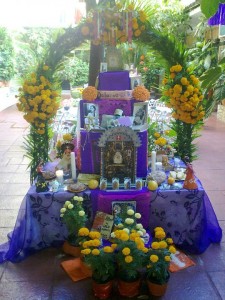(English) Celebrating the Day of the Dead at Hotel Posada de Roger
Posted by admin | Under Sin categoría viernes oct 21, 2011 Like every year in Puerto Vallarta we celebrate
Like every year in Puerto Vallarta we celebrate
the Day of the Dead, developing a series of altars and it involving all the
central Vallarta hotels, including Hotel Posada de Roger. We invite the public
and tourists to take a tour through the various hotels and participate in the
various raffles and festivities going on; on this day.
The Day of the Dead is a Mexican celebration that
honors the pre-Hispanic deceased of November 2, it begins November 1,
coinciding with the Catholic celebrations of All Souls Day and All
Saints
It’s a Mexican holiday that is celebrated in
some Central American countries and in many communities in the United States
where there is a large Mexican and Central American population. UNESCO
has declared the Mexican holiday as Intangible Cultural Heritage of
Humanity
Hotel Posada de Roger always stays true to
its Mexican roots and traditions remembering to never miss the opportunity to
contribute something to our beautiful city.
The origins of the
celebration Day of the Dead in Mexico predate the arrival of the Spanish. There
are records of ethnic celebrations in Mexico, Maya, Purepecha and Totonac. The
rituals that celebrate the life of the ancestors in these civilizations have
been going on for the last three thousand years. In pre-Hispanic era it was
common practice to keep skulls as trophies and have them as display
during rituals to symbolize death and rebirth.
Symbolizes:
- The Sweetend Skulls have the
name written of the deceased (or in some cases of living people, in a joking
manner that does not offend modest in particular mentioned) on their forehead,
and are eaten by relatives or friends. - The Bread
of the Dead is a special dish of the Day of the Dead. It’s a sweet
roll that is baked in different shapes, simple round skulls decorated
with figures of the same bone-shaped pan and sprinkle with
sugar. - The
Flowers. From November 1st to 2nd families usually clean
and decorate the tombs of their deceased with colorful wreaths made of roses,
sunflowers, and among others, but mainly Cempaxóchitl, which is believed
to attract and guide the souls of the dead. During this period all
cemeteries are visited. - The
Offering and the visit of souls. It is believed that the
souls of children return to visit the first day of November, and the souls of
the adults return on second day. In the event that you cannot visit the grave,
either because the tomb of deceased does not exist anymore, or because the
family is to far to go visit them, they can also develop detailed altars
in their homes where offerings are made. Which may be dishes of food, pan de
muerto, water glasses, mezcal, tequila, pulque or atole, cigarettes and even
toys for the souls of children. All this is placed next to portraits of the
deceased surrounded by candles.
Dead
Offerings:
The materials commonly used to make an offering to
the dead on Day of the Dead have a special meaning, and so are others like the
following:
- Portrait of the
person that they are remembering, the portrait of the
dead soul suggesting that they visit on the night of November
2nd. - Paint or chromium for the souls
in Purgatory: This helps for the souls who seemed trapped
in the purgatory; it helps them find their way out. - Twelve flowers, although
they may be less, they must be in pairs, and preferably purple, crowns and
flowers made of wax. The candles, especially if they are purple, are a sign of
mourning. The four candles represent the four cross-quarters, so the soul can
be directed to find their way and their own house. - Marigold flower : The
color represents light as sunlight, when you toss and spread out the flower
petals in form of a road it indicates to them their way
home. - Cross Grounding:
is to remind you of your faith “Remember you are dust and to dust
you shall return”, which is a recall to return to the land
they left. - Pumpkin blemish: This fruit has a
special place in both the pre-Hispanic cuisine and the present. It is part
of the country’s food tetra logy, next to the corn, beans and Chile. It is used
throughout, stems, guides, flowers, fruits and seeds. On the altar it is
prepared fresh, cooked with sugar, cinnamon, hawthorn, pieces of
sugar cane and other ingredients. The candy is
called calabazate crystallized. Preparing the pumpkin blemish is to
introduce this fruit in a basket made of palm leafs. This is the traditional
way, because in the old days it was twice the work.
The altar at Hotel Posada de Roger in Puerto
Vallarta this year will be based on our dearly deceased soul, actor, comedian
and winner of the Globo de Oro in 1957, Mario Moreno also known as “Cantinflas”
a character that was part of the 50s era. Posada de Roger always tries it’s best
to never lose its touch and follow our Mexican culture and makes every possible
detail perfect for our celebration Day of the
Dead.

 Facebook
Facebook Twitter
Twitter Youtube
Youtube